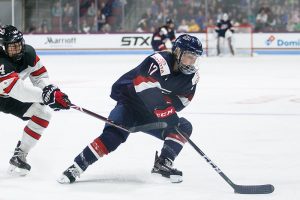With the 2018 Winter Olympics coming to a close, I thought it would be pertinent to discuss one of the most ground-breaking wins for team USA. Last week, the U.S. Women’s Ice Hockey team beat Canada 3-2 in a shootout for the gold medal. The U.S. Women’s team has only won gold once before, in 1998, so this is certainly a win that will go down in history. The team all put in a tremendous effort for the win, but Jocelyne Lamoureux-Davidson, the player that scored the game-winning shot, has become somewhat of an American hero.
As the entire world watched on, Lamoureux Davidson was faced with one of the most high-stakes games of her life. It was all up to her. Now, I don’t know about you, but I get stressed out for something as small as a class presentation or final exam. Her (and the rest of the team’s) ability to work through and cope with extreme stress is truly remarkable. I know for a fact that if I were in that same position, I would certainly crumble.

Figure 1. Jocelyne Amoureux-Davidson playing for Team USA in 2017
Perhaps one of the most profound differences between elite athletes and everyday people is the ability to manage stress, both long and short-term. Most people would recognize the concept of “fight or flight,” that describes the body’s physiological response to stressful situations, or “threats.” This response originally served as a survival mechanism, protecting early humans from life-threatening risks like animal attacks, but people may experience the same stress response to family issues, work, or in this case, hockey shootouts.
The physiological responses to stress are dictated by the sympathetic and parasympathetic nervous system. Perceived threats prompt the sympathetic nervous system to release a cascade of several different hormones and eventually cortisol, a steroid hormone, that keeps the body on high alert. It gives the body an extra burst of energy that can allow the person to either combat the threat (fight) or run away (flight). When the coast is clear, the parasympathetic nervous system is activated to dampen the effects of the hormones.
While it is interesting to study the short term effects of cortisol, some of its most intriguing effects occur in the long-term. Because athletes are constantly faced with high-stress situations, they may experience the effects of chronic stress, including anxiety, insomnia, high blood pressure, and weakened immune system. After years of training and competing, athletes often experience “burnout,” which has the potential to end their high-stress career. In a study published in Psychology of Sport and Exercise in 2016, investigators examined the key factors that contributed to the stress-burnout relationship. It was found that both athlete resilience and coach social support played a crucial role in the moderation of stress and maintenance of psychological health.
After a win, many athletes will take the time to thank their friends, family, and coaches. This may just seem like a nice gesture, but it is scientifically supported that their support can contribute to the athlete’s success. In such a high-stress environment, it is imperative that athletes have access to a support system to help cope with the constant flow of cortisol. Lamoureux Davidson’s coach must be proud.
Further Reading – Works Cited
- “U.S. Women Golden at 2018 Olympics” (2018) by USA Hockey, http://teamusa.usahockey.com/news_article/show/889602?referrer_id=695820
- Figure 1. Attribution: BDZ Sports [CC BY-SA 4.0 (https://creativecommons.org/licenses/by-sa/4.0)], via Wikimedia Commons
- “Understanding the Stress Response” (2011), https://www.health.harvard.edu/staying-healthy/understanding-the-stress-response
- “Understanding Chronic Stress” (2018), http://www.apa.org/helpcenter/understanding-chronic-stress.aspx
- F.J.H Lu, et. al. “Interaction of athletes’ resilience and coaches social support on the stress-burnout relationship: a conjunctive moderation perspective” Psychology of Sport and Exercise (2016) Vol. 22, pp. 202-209
